While modern skyscrapers are designed as instruments of economy and industry, their counterparts in the ancient world were largely defined by the collective religious fervor of the culture. However, in spite of the seemingly theistic inspirations, the science and architectural ‘technology’ supporting these huge man-made ancient structures are incredible, to say the least. But that is a discussion for another list; for now, let us take a gander at the ten tallest man-made architectural triumphs from our ancient world.
*Note – The list does include buildings that are NOT extant, but did exist at some point in history according to various literary evidence.
10) La Danta Temple, Guatemala (built circa 300 BC) – 230 ft or 72 m high
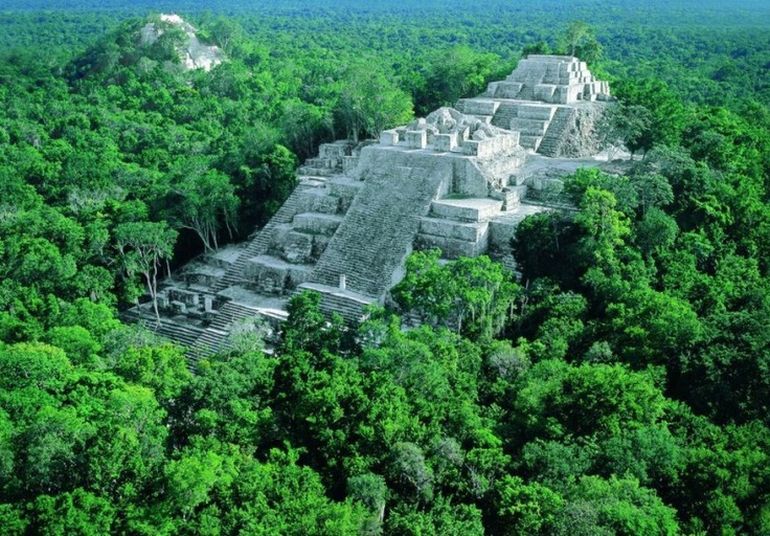
Hidden inside the lush jungles of El Petén, Guatemala, lies the magnificent pre-Columbian Mayan settlement of El Mirador. Only discovered in 1926, this massive temple city flourished from the 6th century BC, while reaching its zenith between 300-100 BC with a peak population of over 200,000 people.
However, beyond its capacity, the settlement is also known for its indigenous arrangement of a ‘triadic’ structure that comprises expansive pedestals topped with a set of three summit pyramids. The greatest of these peculiar structures pertains to the La Danta Temple, which rises to a fascinating 230 ft of height while jutting out from the forest floor.

And while this height may be triumphed by a few Egyptian pyramids, La Danta can be counted among the largest pyramids of the world, with its mind-boggling 2,800,000 cubic m (or 98,805,000 cubic ft) of volume filled with huge rock chunks. In fact, many researchers have further put forth the estimation that La Danta is among the largest structures ever built by humankind, if we also include the gargantuan 18,000 sq m of platform upon which the temple is built.
9) Hwangryongsa Temple, Korea (possibly started circa mid-6th century AD) – 262 ft or 80 m high
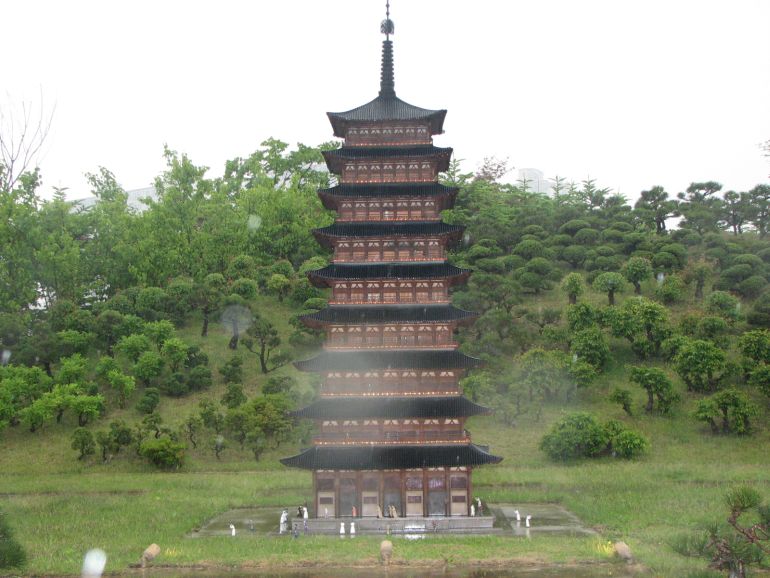
A former Buddhist temple in the city of Gyeongju, South Korea, the Hwangryongsa was probably both the tallest structure in East Asia and the tallest wooden structure in the world during the time of its completion. Designed as a symbolic representation of state-sponsored Buddhism, the very term Hwangryongsa refers to the ‘Golden Dragon Temple’, and it was ceremoniously constructed as an order by King Jinheung who ruled from 540-76 AD.
According to legends, the first proposal put forth by the ruler pertained to a royal palace. But the plan was immediately scrapped in favor of a magnificent temple when a dragon was encountered on the site.

However, given the humongous scope of the endeavor, the temple was apparently not completed until 644 AD. And later on, a nine-story wooden pagoda reinforced by 8 stone pillars and 60 foundation stones, was added to the 18-acre temple complex, and it rose to an impressive height of 262 ft. Unfortunately for both the temple and its conspicuous pagoda, the entire structure was probably destroyed by the rampaging Mongols who invaded Korea in 1238 AD.
8) Etemenanki, Iraq (built circa 601 BC) – 298 ft or 91 m high

The Etemenanki (roughly translating to ‘House of the foundation of heaven on earth’) was supposedly a towering architectural triumph dedicated to the Babylonian god Marduk. Constructed by strategically arranging massive layers of bricks and tiles, such massive monuments were called ziqqurratu or ziggurat, which basically means ‘rising building’.
In this particular case, the Etemenanki was probably the largest of these ziggurats, and it was possibly built within the confines of the ancient city of Babylon. To that end, many researchers have likened it to the actual Tower of Babel mentioned in the Biblical book of Genesis, with the literary work pointing to the geographical location of the legendary structure –
The whole earth was of one language, and of one speech. And it came to pass, as they journeyed from the east, that they found a plain in the land of Šin’âr, and they dwelt there. And they said one to another, “Come, let us make bricks and burn them thoroughly.” And they had brick for stone, and slime had they for mortar. And they said, “Come, let us build us a city and a tower whose top may reach unto heaven; and let us make us a name, lest we be scattered abroad upon the face of the whole earth.
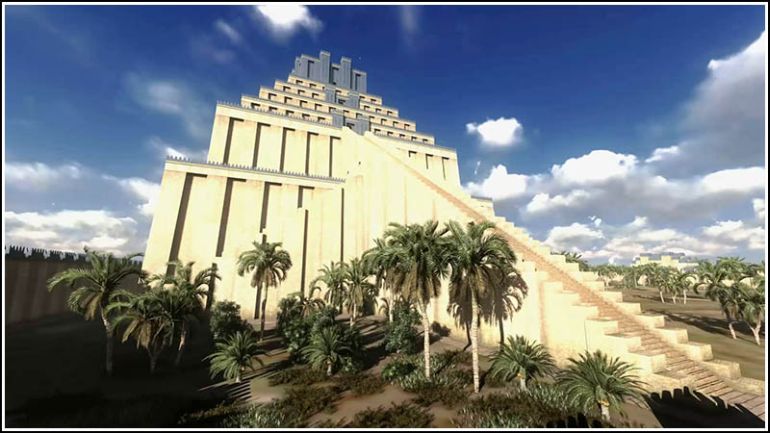
Interestingly, beyond Biblical hyperbole, the description of the Etemenanki was also found in a cuneiform tablet from Uruk, dating from 229 BC. In accordance with this literary evidence, the entire monument was composed of seven terraces, and they collectively rose to a height of 91 m.
But arguably more impressive was the ground floor plan of this gargantuan ziggurat, which measured over 8,200 sq m (or 89,000 sq ft) in the area – thus being equivalent to over 1.5 times a conventional football field. Furthermore, the entire complex boasted of an imposing triple gateway system, with their visual impact showcasing considerable level differences between the entrances, thus alluding to the ambit of a ‘stairway to heaven’ (see above image).
7) Ruwanwelisaya, Sri Lanka (built circa 140 BC) – 300 ft or 92 m high

The ambitious construction of the Ruwanwelisaya was initiated by King Dutugemunu in around 161 BC, but the sheer scope of the grand architectural project outlived the king himself, with the endeavor finally finished by his successor in 140 BC.
The enviable dimensions of the stupa speak for themselves, with the massive tapering dome originally rising to 300 ft, while also having a diameter of around 295 ft (90 m) and a circumference of 950 ft (292 m). So mathematically, the base area of Ruwanwelisaya equates to over 68,300 sq ft, which is bigger than a conventional football field.

Of course, beyond just the gigantic ambit of the stupa, there is a symbolic side to this magnificent affair. As Ceylon Today describes –
The compound of the stupa is surrounded by four walls with elephant figures made into them. It is believed that relics of the Buddha are enshrined within the stupa. The Great Stupa was also designed with the teachings of the Buddha in mind. Its dome signifies the vastness of the doctrine, the four facets above it represent the Four Noble Truths, the concentric rings indicate the Noble Eightfold Middle Path, and the large crystal at the pinnacle represents the ultimate Buddhist goal of enlightenment.
6) Red Pyramid, Egypt (built circa 2600 BC) – 345 ft or 105 m high

The Red Pyramid of Dahshur (built by Pharaoh Sneferu) is the largest pyramid in the Dahshur necropolis, while also being the third largest pyramid in Egypt. More importantly, from the architectural standpoint, the Red Pyramid might have been the first successful attempt by Egyptian engineers and workers to create a smooth-sided pyramid that went beyond just the visual impact.
Some of these special white Tura limestone casings are still visible along the base of the large structure. The other interesting feature of the monument pertains to its shallow 43-degree built angle that endows the entire form with a squat appearance in spite of its impressive size. In fact, the base area of the structure accounts for 48,400 sq m – which is equivalent to almost 9 football fields!

Interestingly, the very name Red Pyramid comes from the slightly reddish hue of the limestone facades that are exposed after the wearing out of the originally smooth casing stones. Oddly enough, the locals refer to the Red Pyramid as el-heram el-watwaat, which roughly translates to the Bat Pyramid.
5) Lighthouse of Alexandria, Egypt (built circa 280 BC) – at least 377 ft or 115 m high

One of the rare instances of Greek architecture that went beyond the human scale to ‘godly’ dimensions, the Lighthouse of Alexandria (also known as the Pharos of Alexandria) constructed by the Ptolemaic Kingdom, may have been the tallest structure in the ancient world, with some accounts mentioning its height to soar up to an incredible 492 ft.
Unfortunately, since the building is not extant, we have to revert to its lowest possible height in accordance with other literary sources – which was still impressive at 377 ft. As Judith McKenzie from the Faculty of Oriental Studies at the University of Oxford, made it clear –
The Arab descriptions of the lighthouse are remarkably consistent, although it was repaired several times, especially after earthquake damage. The height they give varies only fifteen percent from c 103 to 118 m [338 to 387 ft], on a base c. 30 by 30 m [98 by 98 ft] square…the Arab authors indicate a tower with three tapering tiers, which they describe as square, octagonal and circular, with a substantial ramp.

Now in terms of design, the Lighthouse of Alexandria, built from light-hued stone blocks, was vertically divided into three components – the lower-most (and broadest) square section with four huge facades, the thinner middle section with an octagonal plan, and the upper-most slimmest section with a circular plan. The functionality of the enormous structure was related to this upper level, with a mirror being installed atop it that reflected sunlight during the daytime, while the fire was lit during the night.
And given the sheer volume of the facades, the arranged stone blocks of the ancient lighthouse were supposedly reinforced with molten lead so as to withstand the force of the incoming sea waves. Given such advanced engineering credentials, it comes as no surprise that the Lighthouse of Alexandria was considered one of the Seven Wonders of the Ancient World.
4) Jetavanaramaya, Sri Lanka (built between 273–301 AD) – 400 ft or 122 m high

Located in the sacred world heritage city of Anuradhapura, the Jetavanaramaya boasted the largest stupa in the entire world (while also holding the honor of the tallest stupa in the ancient world). When translated to sheer figures, the originally 400-ft tall stupa accounted for an astronomical base area of 233,000 sq m (2,508,000 sq ft) – which is equivalent to 43 football fields!
This massive structure was estimated to be constructed from 93.3 million baked bricks (each of which could withstand loads of up to 166 kg), with one side of the enormous stupa measuring 576 ft (176 m) in length.
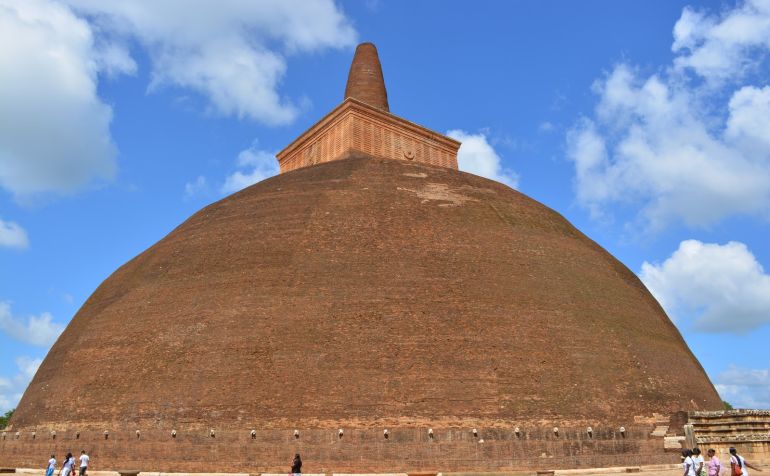
Suffice it to say, the Jetavanaramaya compound also pertains to a massive area, which accounts for 5.6 hectares that had housed over 10,000 Buddhist monks in its heyday. And intriguingly, the majestic size of this stupa was fueled by religious tensions between the Theravada and Mahayana sects of Buddhism.
In that regard, King Mahasena of Anuradhapura made his impactful statement by destroying a previous Mahavihara (monastic complex of viharas) and then patronizing this engineering project that favored the Mahayana sect over orthodox Theravadins. Now, in its current state, the original building being long destroyed, was substituted by a smaller structure that is 232 ft (71 m) in height, built in the 12th century.
3) Yongning Temple, China (built around 516 AD) – 448 ft or 136.7 m high

The second entry in the list that pertains to an architectural triumph that doesn’t exist anymore, the Yongning Temple was supposedly constructed in the early 6th century under the patronage of Empress Dowager Hu. Originally located in Luoyang City, not much is known about the structure other than some anecdotes that describe its apparent extravagance.
On account of such literary evidence (like Yang Xuanzhi’s records), the temple was built like a magnificent palace that also encompassed a royal gate, massive walls, and over a thousand monk dormitories.

These imposing spatial components were visually defined by gilded red paint while being embellished with gold nails, chains, and bells. 130 of these bells were supposedly arranged at the four corners of the complex, and their collective chiming was said to be heard over miles away on particular windy nights. However, beyond just the grandeur of the architecture, the ‘piece de resistance’ of the temple complex is arguably related to the incredibly large Yongning pagoda that rose to 448 ft in height.
Unfortunately, according to the Temple Records of Luoyang, the tower was entirely destroyed by fire in the third year of Yongxi (534 AD) – with the flames taking more than three months to subside after encompassing the huge breadth of the structure. Later on, the Mongols may have played their part in vandalizing the rest of the majestic architectural specimens.
2) Pyramid of Khafre, Egypt (built circa 2530 BC) – 471 ft or 143 m high

The second largest structure in the renowned Giza pyramid complex and also the second tallest pyramid in the world, the Pyramid of Khafre currently rises to a height of 448 ft (while its original height equated to 471 ft) and has a base length of 215.5 m (706 ft), thus accounting for a humongous 46,770 sq m (498,436 sq ft) of the area – which is equivalent of over 8 football fields. Interestingly, the entire structure was already built upon an elevated bedrock of 10 m (33 ft), which makes it appear higher than the actual pyramid’s mathematical height.
Now while the Pyramid of Khafre probably didn’t boast of as many regularly placed casing stones as the higher Pyramid of Khufu, the constructional techniques and arrangements of the 2-ton stones were similar to its predecessor. However, the Pyramid of Khafre (often overlooked by its larger cousin) greatest claim to fame arguably relates to the Great Sphinx, the largest monolithic statue in the world.

That is because this incredible monument was a probable inclusive part of the vast Khafre complex built during the same time and possibly created from the same rock formations used for the giant pyramid (at least, that is the dominant view held by the majority of the Egyptologists).
1) Pyramid of Khufu, Egypt (built circa 2570 BC) – 481 ft or 146.6 m high
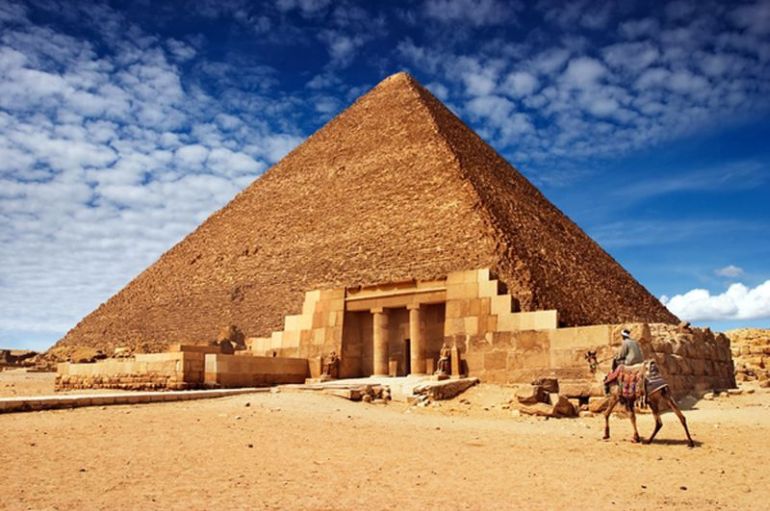
Also aptly known as the Great Pyramid of Egypt, the over 4,500 years old Pyramid of Khufu is the oldest and the tallest man-made structure in this list. As a matter of fact, it held the record for the tallest architectural specimen even created by humankind for over 3,800 years (until toppled by the old St. Paul’s Cathedral in 1240 AD).
Interestingly, beyond just the height (currently specified at 455 ft, due to soil erosion), it is the gargantuan volume of the pyramid that has baffled many a historian and engineer over the years. To that end, the monumental giant has a base area of around 570,000 sq ft and a gargantuan volume of 88 million cubic ft (or 2.5 million cubic m) that accounts for an extraordinary 5.9 million tons of mass.
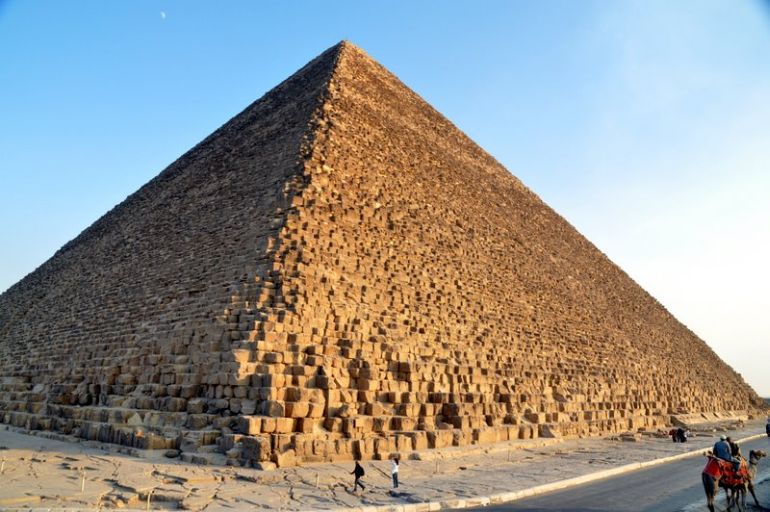
This extraordinary scope was achieved by the use of 2.3 million stone blocks (ranging from 2 to 30 tons) – that equates to an average of 800 tons of stones being installed each day, with 12 stones being painstakingly yet precisely arranged every hour!
Mysteriously enough, in spite of such grandiose credentials, archaeologists have never been able to find any mortuary remains of Pharaoh Khufu (or Cheops in Greek), or any other kingly remains inside the massive structure. In fact, the only surviving portraiture of Khufu – the second Pharaoh from the Fourth Dynasty, pertains to a tiny 3-inch ivory figurine that was discovered separately from the pyramid in the early 20th century.




Be the first to comment on "10 Tallest Architectural Triumphs From The Ancient World"